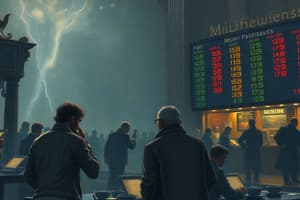Podcast
Questions and Answers
When compared to traditional markets, sports markets are generally considered:
When compared to traditional markets, sports markets are generally considered:
- More stable due to consistent consumer behavior.
- Less experience-driven and more predictable.
- Experience-driven and unpredictable. (correct)
- More controlled by regulatory bodies.
Which of the following is a characteristic of the sports market, contrasting with the traditional market?
Which of the following is a characteristic of the sports market, contrasting with the traditional market?
- Rational demand where consumers prioritize quality and price.
- Predictable product quality and consistency.
- Flexible supply that adjusts to consumer demand.
- Emotional demand where fans remain loyal regardless of performance. (correct)
In a traditional market, what is the primary driver of revenue and profits for businesses?
In a traditional market, what is the primary driver of revenue and profits for businesses?
- Selling goods and services along with advertising. (correct)
- Controlling competition through monopoly behavior.
- Influencing consumer behavior through emotional appeals.
- Media rights deals for broadcasting content.
What primarily causes a shift in the demand curve for sports merchandise?
What primarily causes a shift in the demand curve for sports merchandise?
According to demand curve principles, what happens when there is an increase in demand for tickets, assuming the price remains constant?
According to demand curve principles, what happens when there is an increase in demand for tickets, assuming the price remains constant?
Which statement accurately describes the graphical representation of a demand curve?
Which statement accurately describes the graphical representation of a demand curve?
According to the principles of demand, what is the key difference between 'demand' and 'quantity demanded'?
According to the principles of demand, what is the key difference between 'demand' and 'quantity demanded'?
How does consumer surplus arise in the context of sports tickets?
How does consumer surplus arise in the context of sports tickets?
In demand curve mathematics, what does 'm' represent in the equation P = -m(Q) + b?
In demand curve mathematics, what does 'm' represent in the equation P = -m(Q) + b?
What is the likely impact on the demand curve for team merchandise if several star players unexpectedly retire?
What is the likely impact on the demand curve for team merchandise if several star players unexpectedly retire?
Which of the following scenarios would likely cause the demand curve for a particular sports team's tickets to shift outwards?
Which of the following scenarios would likely cause the demand curve for a particular sports team's tickets to shift outwards?
Why is the supply curve for stadium seats typically represented as vertical?
Why is the supply curve for stadium seats typically represented as vertical?
What does it mean for the demand for a sports team's tickets to be 'elastic'?
What does it mean for the demand for a sports team's tickets to be 'elastic'?
Which of the following would typically be considered a determinant of whether the demand for a specific good is elastic or inelastic?
Which of the following would typically be considered a determinant of whether the demand for a specific good is elastic or inelastic?
What does a sports team need to do to successfully discriminate prices?
What does a sports team need to do to successfully discriminate prices?
Which of the following is a characteristic of large-market sports teams compared to small-market teams?
Which of the following is a characteristic of large-market sports teams compared to small-market teams?
A sports league that operates as a monopoly in a particular sport in a country can:
A sports league that operates as a monopoly in a particular sport in a country can:
What is the primary goal of 'utility maximizing' in the context of sports team management?
What is the primary goal of 'utility maximizing' in the context of sports team management?
In game theory, what is the definition of a 'pure strategy'?
In game theory, what is the definition of a 'pure strategy'?
Which of the following describes 'screening' in the context of sports team management?
Which of the following describes 'screening' in the context of sports team management?
Flashcards
Sports Markets
Sports Markets
Experience-driven, unpredictable markets, unlike more stable, controlled traditional markets.
Traditional Market
Traditional Market
Companies produce more based on demand; consumers choose based on quality/price.
Demand Curve
Demand Curve
Static representation of existing market info; shifts signify new market information.
Demand Shifters
Demand Shifters
Signup and view all the flashcards
Increase in Demand
Increase in Demand
Signup and view all the flashcards
Decrease in Demand
Decrease in Demand
Signup and view all the flashcards
Graphical Demand Curve
Graphical Demand Curve
Signup and view all the flashcards
Consumer Surplus
Consumer Surplus
Signup and view all the flashcards
Willingness to Pay
Willingness to Pay
Signup and view all the flashcards
Sports Consumption
Sports Consumption
Signup and view all the flashcards
Normal Goods
Normal Goods
Signup and view all the flashcards
Inferior Goods
Inferior Goods
Signup and view all the flashcards
Complements (goods)
Complements (goods)
Signup and view all the flashcards
Substitutes (goods)
Substitutes (goods)
Signup and view all the flashcards
Supply Curve Stadium Seats
Supply Curve Stadium Seats
Signup and view all the flashcards
Supply Curves
Supply Curves
Signup and view all the flashcards
Elasticity
Elasticity
Signup and view all the flashcards
Elastic good
Elastic good
Signup and view all the flashcards
Inelastic good
Inelastic good
Signup and view all the flashcards
Unit Elastic good
Unit Elastic good
Signup and view all the flashcards
Study Notes
- Sports markets are experience-driven, unpredictable contrasting traditional markets that are stable and controlled.
Sports Market
- Key aspects include fixed supply, emotional demand, unpredictable products, revenue from media rights, and monopoly behavior
- Fixed supply: Limited stadium seats and controlled league expansion.
- Emotional Demand: Fans stay loyal regardless of performance.
- Unpredictable Product: Game outcomes vary, affecting value.
- Revenue from Media Rights: TV and streaming deals drive major profits.
- Monopoly behavior: Leagues control competition and limit new teams.
Traditional Market
- Characteristics include flexible supply, rational demand, predictable products, revenue from sales & ads, and a competitive market
- Flexible Supply: Companies can produce more based on demand.
- Rational Demand: Consumers switch products based on quality and price.
- Predictable Product: Businesses control product quality and consistency.
- Revenue from Sales & Ads: Profits mainly come from selling goods/services.
- Competitive Market: New businesses can enter freely, increasing competition.
Demand for Sport
- The demand curve shows static market information and is driven by Willingness to Pay (WTP).
Demand Shifters
- Shifts along the demand curve are caused by price.
- An unchanging price creates increased demand causes an outward curve shift.
- People will demand more of a good for the same price
- An unchanging price creates decreased demand causes an inward curve shift.
- People will demand of a good for the same price.
Graphical Demand Curve
- Demand curves are downward-sloping.
- A changing demand curve indicates that new information appeared.
- Price decreases = quantity demanded increases.
- Price increases = quantity demanded decreases.
Demand Function
- Solving for Price/Quantity helps to determine the impact of changes
Demand and Quantity Demanded
- Demand doesn't change according to changes in price, quantity demanded changes, only price can change quantity demanded
Demand for Sports
- Includes tickets, viewership, and merchandise, all exhibiting different WTPs from consumers.
Consumer Surplus
- Some consumers are willing to pay more than the set price and receive surplus.
- They earn utility by buying at a lower price
Willingness to Pay
- How much are people willing to pay for a certain good.
- Graphing everyone's WTP produced a demand curve is driven by WTP.
- Equation to calculate consumer surplus = ½ quantity * (demand intercept – price)
Ways sports are “consumed"
- Buying tickets, watching on TV, buying merchandise, and following teams/players on social media.
Demand Curve Math
- P = -m(Q) + b
- P is the price
- Q is the quantity demanded
- m is the slope of the demand curve (the rate at which price decreases as quantity increases).
- b is the intercept (where the demand curve crosses the Y axis)
- P=-mQ+b⇒P+mQ=b⇒mQ=b-P ⇒ Q =-1/mP+b/m⇒ Q = -nP + c
- If stadium seats 20,000 people, and we want to sell every seat, price should be set at $60.
- To sell tickets for $80, 10,000 seats are sold.
Demand Curve Shifters
- Changes in income, tastes, or preferences shift it.
- If income changes, the demand curve shifts
- A sport gaining or losing popularity create shift in demand, if a sport becomes more popular = curve shifts outwards
- Shifts in the price of substitutes/complements, future expectations, and population also cause change.
Change in Tastes or Preferences
- The demand curve will shift outwards should a sport becomes more popular
- The demand curve will shift inwards should a sport falls out of fashion
Expectations about the Future
- Demand may shift if people think something will become rarer/more expensive.
- Demand may decrease if something is expected to become cheaper.
- Changes in demographics and team performance also cause change.
Scarcity
- Resources are finite, there is more "want" for a good than that good exists , sports are subject to scarcity related to QBs, NFL teams, MLB teams and competitive games.
Types of Goods
Normal goods
- Goods whose demand increases when incomes increase (cars, houses, luxury goods)
Inferior goods
- Goods whose demand increases when incomes decrease (ramen, dollar stores, etc.)
- Sports consumption is mostly a normal good because demand increases as income rises via tickets, merchandise and subscriptions
Complements
- Goods that go together Ex: Hot dogs & Hot dog buns, movies & popcorn
- If the price increases for Good C, quantity demanded for Good C will decrease and Good D, because they also can't consume Good C
- Sports viewership and purchasing sports equipment, Super Bowl Halftime are examples of complementary goods
Substitutes
- Goods that act as substitutes for other goods Ex: Hot dogs & Hamburgers, Coke & Pepsi
- If the price of Good A increases, its quantity demanded will decrease, the reverse is True
- Demand for Good B will increase, as consumers substitute Good B for Good A
Supply Curve
- For stadium seats the supply curve is vertical because of the number of seats.
- No matter price increases, the number of seats remains fixed.
When the supply curve is not fixed
- Sporting goods, athletic clothing, gyms, and players are aspects that change the supply curve because there is a correlation, unlike stadium seats
Elasticity
- Elasticity measures how sensitive quantity demanded is to a change in price and is always negative.
- Supply curves are upward sloping due to more sellers at higher prices, price changes cause changes in quantity supplied
Formula to Calculate
- Percentage Change = (New # - Old #) / (Old #)
- Elasticity = (%∆ Quantity Demanded) / (%∆ Price) = ((New quantity demanded –Old quantity demanded) / (old quantity demanded) (New price -Old price) / (Old price)
- Elasticity of Stadium Attendance Demand = (% △ Attendance Demand) / (%∆ Ticket Price) = (New attendance demanded –Old attendance demanded) / (old attendance demanded) ) (New price -Old price) / (old price)
Types of Elasticity
Elastic
- Change in price leads to a relatively large change in the quantity demanded in most smaller sports teams(minor league baseball), even small changes in price drastically alter quantity demanded.
Inelastic
- Described a good results only small change in the quantity demanded in Dallas Cowboys, UGA football, they show less elastic demand Prices can increase substantially without altering the number of seats sold Games matter because regular season games may be elastic, playoff games are often inelastic
Determinants of Elastic/Inelastic Demand
- If Elasticity < -1, that good demanded is elastic and small price changes cause large changes in quantity, ex. luxury/”brand” consumer goods.
- If Elasticity > -1, that good demanded is inelastic with large price changes cause relatively small changes in quantity, ex. Power, water, gasoline.
- If Elasticity = -1, that good demanded is unit elastic, changes in price create equal change in quantity and are rare in real life.
Elasticity Determinants
Proximity of substitutes
- More substitutes => more elastic
- Value of the good/service: More valuable => more elastic
- Necessity for survival: More necessary => less elastic
- Brand loyalty: More loyal consumers => less elastic
- Time: Goods become more elastic over a longer time horizon
Small-market vs. Large-market teams
Large Market Teams
- Teams have larger fan bases, generating more revenues and being more valuable, however not more profitable
- They have higher costs, wages, rents, are located in major metropolitan areas (e.g., New York, Los Angeles, Chicago), and have larger fanbases, leading to higher ticket/merchandise revenue.
- Examples: New York Yankees (MLB), Los Angeles Lakers (NBA), Dallas Cowboys (NFL).
Small Market Teams
- Located in smaller lower revenue due local TV deals, rely on drafting/player development and can struggle to retain superstars.
- Examples: Milwaukee Bucks (NBA), Green Bay Packers (NFL), Kansas City Royals (MLB).
Revenue calculation
- It is possible for teams in large cities do not mean team will have more fans or will be more profitable,
- Revenue = Price * Quantity Sold
Profit
- Profit = Total Revenue - Total Cost
- Accounting profit v. economic profit = Accounting Profit = Profit = Total Revenue - Total Cost
- Economic Profit = Total Revenue - Total Cost - Opportunity Cost +/- externalities
Marginal Revenue
- The revenue from selling one more good is found by the amount revenue gained from selling the previous quantity compared to the next, Marginal Revenue = -2mQ+b
- Marginal Revenue to Elasticity = P (1- (1/Elasticity))
Costs
- Fixed Cost: Costs are paid regardless of items sold.
- Variable Cost: Costs vary based on how many items are sold.
- Total Cost: is the sum of fixed and variable costs with the equation TC = TFC + TVC
- Opportunity Cost: is the best option that is given up.
- Marginal Cost: is the cost of producing one more unit.
Utility Maximizing vs. Satisficing
- Concepts which describe how decisions are made centered on different goals.
Utility Maximizing
- Maximize decision making using possible choices to get value, spending money on free agents to a championship and training year round.
Satisficing
- Satisficing meets a minimum standard rather than maximizing benefits, finding an option to meet a minimim quality
Price Discrimination
- Sports teams segment the demand curve so people with a high WTP pay more, and people with a low WTP pay less.
- Those with a lower WTP pay less, those with a higher WTP to pay more, needed to identify segments that would have identification/proof (student or social security ID card), booking in advance (to separate business from non-business travelers).
- Disadvantages include higher prices for some, consumer surplus falling and predatory pricing.
Advantages of Price Descrimination
- Higher revenues and some consumers pay lower than market price
Arbitrage
- It's possible to “cheat” a segmented market and pay lower than WTP by taking advantage of price differences in different markets to pay less or make a profit/ Buying cheaper tickets in one market and reselling them for more.
Broadcasters
- Broadcasters allow networks to share the wealth, prevent formations of rival leagues, because demand is more inclastic so they want to bundle advertisers products.
Advertising Works
- The more people watching TV = more money for the broadcaster
- To maximize profits: know demographics and target them carefully
TarGeted Adds
- Ads can be targeted towards bringing loyal customers back
Blackouts
- Games are not aired in areas to encourage attendance between substitutes
Bundling
- Where a company sells multiple networks (NFL, NBA etc) on TV through a package.
Markets
- Monopoly is one seller, Monopsony is one buyer
Market power is determined by industry
- High startup costs, brand loyalty, and barriers
Monopoly
Characteristics
- Very high barriers to entry, inelastic demand, no close substitutes and economies of scale, natural monopoly (legal restrictions)
Monopoly in sports
- Are commonly found within league play
Monopsony
- Is present in all major sports as one main buyer from many sellers.
Competitive Balance
- Ensures every team has the same odds of winning
League Goals
- To ensure an increased viewership and interest
Gini Coefficient
- Measures balance
Scale to Determine
- A Gini coefficient of 1 means perfect inequality
- A Gini coefficient of 0 means perfect equality
Rival Leagues
- Rival leagues are more successful in non-established markets and focus on cultivating stars.
Short Run and Long Run
- Short Run: Fixed costs
- Long Run: All costs can change
Costs:
- Short Run: fixed
- Long Run: all costs can change
Relocation and Expansion
- Provide owners new markets, maintain relevancy and prevent rivals, but dilutes the game.
League Relocation of Teams allows owners to relocate franchises for more profit.
Single-entry Cooperation
- Centralizes control in the league instead of the teams.
- Leagues balance schedule, enforce rule and select champions
Leagues
- Leagues get into franchise agreements to enforce all rules
Commissioner
Enforce single-entry through territory
- Teams have to play each other, so the league has to keep teams in line
- Prevents competitors
Cheating
Cheating Occurs when - U>PF
- Benefit, likelihood of conviction and the punishment for said crime.
Ways To Reduce
- Make punishments more severe, make punishments more likely
Game Theory
- Decisions where decision makers interact in games.
Mixed Strategy
- Selecting actions based on a probability.
Wages
- Wages are determined by a worker's marginal revenue product (MRP)
- Workers will be hired if MRP > MC - won't be hired if there's more cost than product - This leads to a need for screening.
- This leads to a need for bettering the odds
Information screening.
- Is best found through
- Signalling
- asymmetric
Screening
- Bettering the odds through signaling and information management through various processes
Asymmetry
- The seller knowing their own business
- A buyer knowing how much they wanna pay
2 Common Asymmetries
- Adverse selection and Moral Hazard
- Solutions can be found through signal and screening
- Sports Market
- Live experience
- Traditional
- Tangible and standardized
- They should correlate, consumers are rationally the same, and revenue is equal due to consistent demand through advertising.
Studying That Suits You
Use AI to generate personalized quizzes and flashcards to suit your learning preferences.
Related Documents
Description
Explore the contrasting characteristics of sports and traditional markets. Sports markets feature fixed supply and emotional demand, while traditional markets have flexible supply and rational demand. Understand how unpredictability and media rights shape the sports industry.





